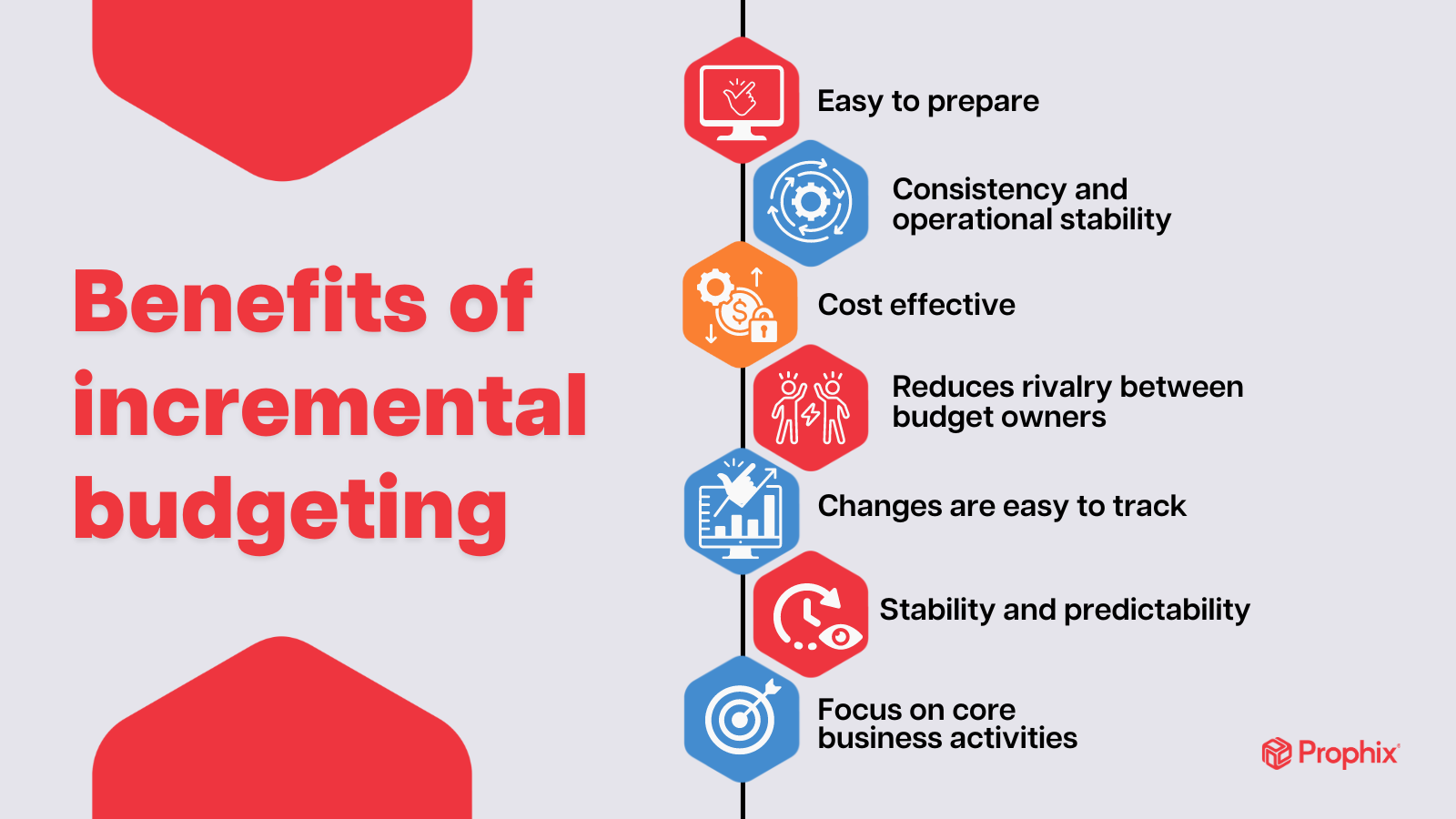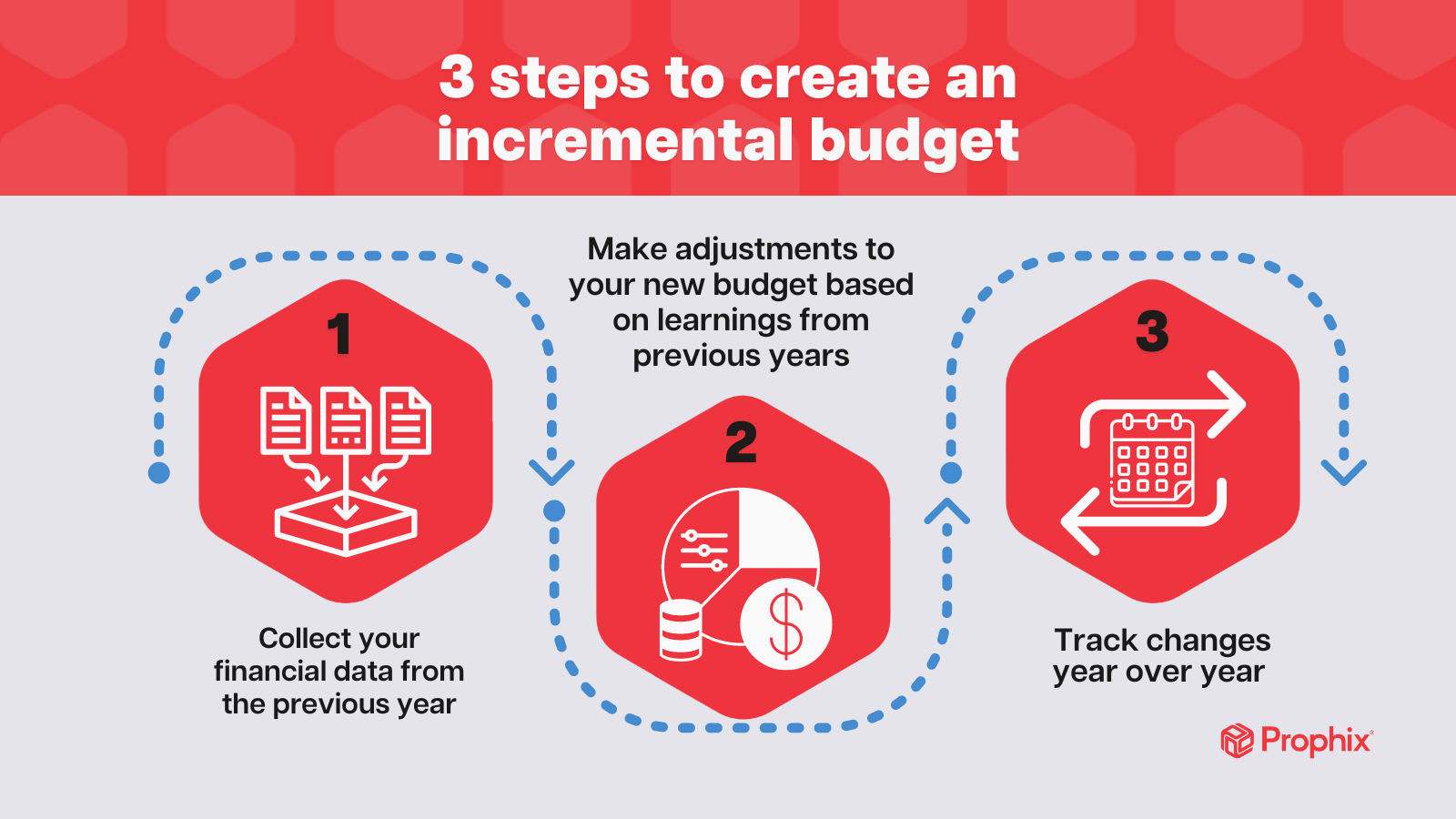What is incremental budgeting?
Incremental budgeting is one of the major budgeting methods.
The premise is simple and effective: your current budget worked well. Why change what's working? Just adjust it.
This is more akin to performing budget maintenance than it is to creating a new budget. For many companies with lean finance teams, this is an attractive proposition.
But how do you actually do incremental budgeting? And how does it compare to other budgeting methods?
That's exactly what we'll cover in this article.
What is incremental budgeting?
Incremental budgeting is a budgeting method that makes adjustments—the increments—to the previous year's budget. Budgeting teams typically accomplish this by incrementing budget allowances for the increase in costs due to raising rates, inflation, and so on.
Unlike other budgeting methods like zero-based budgeting, incremental budgeting has the benefit of being quicker to accomplish. In this sense, incremental budgeting is a major alternative to zero-based budgeting.
Why do companies create incremental budgets?
Companies create incremental budgets because the incremental budgeting method is simple and consistent.
As we'll see, this is best when there aren't huge changes on the horizon. A startup is less likely to use an incremental budget; however, a manufacturer or ecommerce business might be more likely to use one.
Why is incremental budgeting important to understand?
Incremental budgeting is important to understand because it's the most intuitive of the budgeting methods. Incremental budgeting is the aphorism "If it ain't broke, don't fix it" as a budgeting process: it assumes that the previous year's budget was correct and only in need of adjustments.
While there are certainly cases where this is true, budgets often benefit from a more critical eye. Naming the phenomenon of adjusting the budget allows teams to more consciously elect to follow through with the process or choose something else.
When is it best to use an incremental budget?
It's best to use an incremental budget when the previous year's budget was more or less correct and when there are no known upcoming events that would require a change to the budget.
Benefits of incremental budgeting
Besides being simple and therefore quick to prepare, incremental budgeting has plenty of benefits.
Easy to prepare
Incremental budgets are easy to prepare. Most of the work has been done—the base budget was made last year. From there, all that finance teams need to do is analyze the variance from that budget and adjust the new budget to correct those variances.
Consistency and operational stability
Department leaders like incremental budgets because it means they know, more or less, what to expect and how to allocate their resources. This, again, assumes optimal spending on that part.
This consistency leads to operational stability: without large swings in the budget, department heads don't need to cut or scale back their activities. In other words: because not much is changing, not much will go wrong because of the changes.
Cost effective
Incremental budgets are quick to prepare, which makes them more cost effective to prepare, too.
There's a perspective that says a lot of the work finance does can be seen as waste: why build a new budget from the ground up when the previous budget was 80% of the way there?
For some companies, that's not an acceptable argument: their risk tolerance is too low, their finances are too tight, or their growth goals are too aggressive. But for other companies, it makes perfect sense, and it's a great way to open up time for forecasts, modeling, compliance, and the other activities the finance team is responsible for.
Reduces internal rivalry between budget owners
There's very little internal politics during an incremental budgeting process. Because you're using the previous year's budget as a base, the large percentage split by department has already been decided.
This means department leaders will spend less time and energy on getting a larger slice of the pie and instead advocate for their own departments. It changes the focus from "you're giving too much to Sales" to "Marketing needs a little more for X, Y, and Z initiatives."
Changes are simple to track
Because you're using the previous year's budget as a base, any changes year-on-year are super easy to track and find.
Of course, the more you fiddle with the budget—adding departments and categories and the like—the more difficult it becomes to track changes. But in that sense, you can simply roll up to a larger category and compare at that level.

Drawbacks of incremental budgeting
While incremental budgeting has plenty of reasons to recommend it, there are real cases where it's not the best choice. Let's look at some of its limitations.
Promotes excess spending
Because you're using the previous year's budget as a base, the incremental budgeting process can promote excess spending because it allows false assumptions to slip through the budgeting process.
For example, say you've over-budgeted the Marketing department by $1M. They decide to spend that on ads, which isn't giving the expected ROI.
Without a detailed analysis, it's possible that the Marketing department will get even more money in the new year per the incremental budgeting process.
Another related scenario: because department leaders want to increase their budget, they might spend more money to "prove" that they need more money. While suspecting department leaders and budget owners of not having the broader company's interest at heart by overspending is never a good feeling, it remains the finance department's job to be the steward of the budget. Overspending is a real danger of any lazy budgeting process, not just the incremental budgeting one.
Encourages budgetary slack and inefficiency
Because incremental budgeting tends to be a quicker, simpler affair, there's more chance for excess budget or poorly managed funds to get signed off as part of the new budget.
Discourages innovation
Unfortunately, the very nature of incremental budgeting discourages innovation. Since you're using the previous budget as a base, there's not much room for new ideas.
This trickles down into department leaders—unless there's enough of a budget increase for department leaders to invest in something new, this budgeting method actively discourages that because their funds have already been allocated.
Furthermore, this can lead to some discord between a company's need to be agile and its need to have a yearly budget.
Fails to account for external changes and factors
Unless there's already a slush fund in the budget, the net result of the incremental budgeting process is that the budget isn't suited to react to marketplace changes.
One strategy teams can use to solve this problem is adding slush funds to the budget, to be allocated as the finance department sees fit throughout the year. However, that comes with its own set of advantages and disadvantages: setting aside large amounts of cash for a slush fund is a luxury, and there's always the opportunity cost of using that cash for something more obviously impactful.
Limited analysis
A final problem of incremental budgeting is that it discourages the budgeting team from performing a thorough analysis of the company's finances. This is the root of many of the problems alluded to earlier—a limited analysis is how budgetary slack and excess spending creep in.
How to create an incremental budget
So how do you actually create an incremental budget? It's pretty simple. Broadly, here are the three steps you should follow.
1. Collect your finances from the previous year
Gather all your finances from the previous year into one document. It's cleanest if you do a budget variance analysis to set yourself up nicely for the next step.
2. Make adjustments to your new budget based on learnings from the previous year(s)
Now you follow the results of your budget variance analysis and make those adjustments to the budget to create the new year's budget.
Be certain to anticipate trends and think about the company's overall plan, if possible. Some increments or decrements might be greater than others based on the data available to you this year. Consulting the company's strategic plan is a great way to ensure the changes you make to the budget are aligned with the organization's overall growth goals.
3. Track changes year-on-year
Finally, you want to track changes year-on-year. This helps for a couple of reasons: first, it allows you to look back at previous years and see the balance of budgetary allocations, which can serve as a valuable reference point for reproducing the business of that fiscal year.
Second, it helps you tell a story with your numbers: if NDR is steadily growing because you increase the customer success and marketing team budget, that's an argument to make smarter adjustments in the coming years.

Incremental budgeting vs. other budgeting methods
How does incremental budgeting stack up compared to other budgeting methods? While incremental budgeting's share of advantages and disadvantages give it a clear use case, it's still helpful to see a comparison with other budgeting methods.
Incremental budgeting vs. zero-based budgeting
Incremental budgeting and zero-based budgeting might be polar opposites.
With incremental budgeting, you're not starting from zero, as the name of zero-based budgeting implies. Instead, you're starting from a base that's 80% of the way there and only requires a few tweaks. The zero-based budget requires being built from the ground up.
So incremental budgeting is much faster than zero-based budgeting.
However, zero-based budgeting solves all of the drawbacks seen from teams using the incremental budgeting approach. Excess spending, budgetary slack, and limited analysis are not concerns for the team using a zero-based approach. Likewise, innovation and external factors are front-and-center in the minds of the zero-based budgeting team since building the budget from zero requires much more consideration.
Incremental budgeting vs. activity-based budgeting
Incremental budgeting is similar to activity-based budgeting, and arguments can be made that incremental budgeting is a subset of activity-based budgeting.
Activity-based budgeting is a budgeting process where activities that incur costs are recorded, analyzed and researched. From there, the finance team creates a budget based on a detailed analysis of those activities.
It's a much more rigorous process than incremental budgeting and is more aligned with the real activities of a company.
Activity-based budgeting has the advantage of tightening budgetary slack, too, since you're only allocating funds for company activities. Since this gives the finance team and department leaders an opportunity to examine those activities, theoretically the extraneous or inefficient activities will be eliminated.
Incremental budgeting vs. value-proposition budgeting
Value-proposition budgeting, also called priority-based budgeting, is all about analyzing and justifying the value of every single item on a list of expenses. Compared with incremental budgeting, value-proposition budgeting takes much longer but completely eliminates excess spending and budgetary slack.
That said, value-proposition budgeting can go awry depending on who is at the budgeting table. So it's important, when following a value-proposition budgeting process, to keep teams aligned with the company's overall mission and goals.
Conclusion: Incremental budgeting with Prophix
Now you know all about incremental budgeting. What it is, how it works, why you might use it, what to avoid, and how it stacks up against other budgeting methods.
And if you're ready to put incremental budgeting to action, Prophix can help.
With Prophix, you can import all your previous financials, easily perform a budget variance analysis, and produce a new budget to use as a base for forecasts and scenarios.
Click the link to try Prophix today. See what you can do with Prophix.
